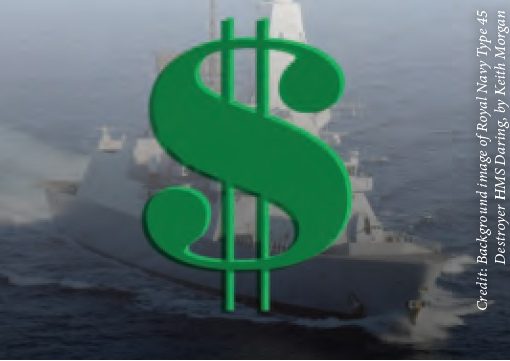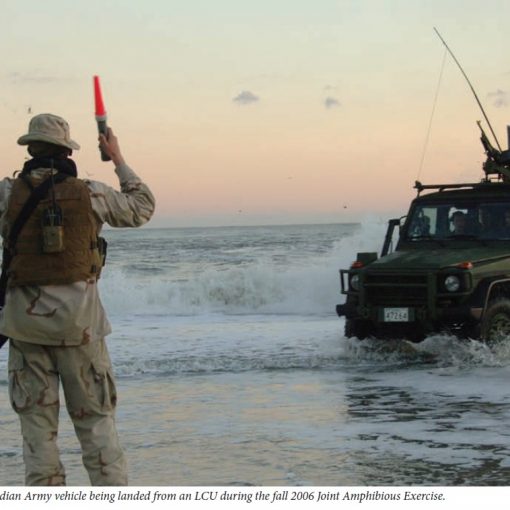As Canada readies for a new defence review, Australia has just released its long-awaited Defence White Paper, along with an Integrated Investment Program as well as a Defence Industry Policy Statement (available here along with associated documents).
Unsurprisingly for an island continent, the White Paper is centred around a maritime-based strategy with a focus on Southeast Asia and the emerging threat posed by China to the region. To counter this threat, the Australian government proposes significantly enhanced maritime warfare capabilities over the next 20-30 years.
Perhaps the most striking of these naval capabilities will be the acquisition of 12 “regionally superior” conventional submarines. The fact that these submarines will be based on a Competitive Evaluation Process between three offshore designs (Japanese, German, French) has already raised a firestorm of protest from local Australian shipbuilders. Australia’s experience with the notorious Collins-class submarines still resonates down under. Perhaps more surprising still, the Expert Panel which surveyed public opinion preparatory to the release of the White Paper, found that the number one question from Australians was: why are we not acquiring nuclear-powered submarines?
The Australian focus on submarines raises a similar issue for Canadian policy makers. What, if anything, does the current government propose to do about a replacement for Canada’s current fleet of 4 Upholder-class diesel-electric submarines? Where might such replacements fit in Canada’s defence strategy of the future? How would such submarines be acquired given the home-build philosophy of the National Shipbuilding Procurement Strategy?
As always, the Australian example provides an interesting comparative foil to similar approaches and problems in Canada.





3 thoughts on “Australia’s 2016 Defence White Paper”
Australia’s naval modernisation over the last 15 years is an example of what is possible for Canada.
Australia didn’t bother building it’s next generation amphibious and oiler assets as they are relatively low tech. An 80% foreign build allows the more advanced intergration of systems work at home but time/cost savings. It stops these “dumb” projects clogging up shipyards.
The focus is three sustainable product lines for continuous build around a 40 year cycle for Austal corvettes in Perth ASC frigates/destroyers in Adelaide and ASC submarines in Adelaide. This will provide capability and cost benefits with a fringe benefit to export and support for regional navies. NZ frigates, Malaysian subs; build and support contracts are likely. Australia has also spent 2 decades refining it’s next Gen frigate systems around the indigenous Saab combat system and CEA FAR radar. Australia has been sounding out Spain for foreign sale of these systems – a result of the good commercial and political relations built with the Aussie AWD, LHD and now AOR projects.
This will eventually allow Australia to deploy, sustain and lead a coalition or national task force consisting of deployed AOR, LHD, DDG and 3 FFG assets.
Ditch the Canada first policy as no war is fought in a vacuum. It is duplication of multinational security assets and holding back meaningful capability, especially when you are lucky enough to be a NATO member. Focus on joint operations and develop a task force sized deliverable capability.
A force structure split 50/50 east west for Canada should look something like:
2 LHD – mistral/Juan Carlos type (Vimmy Ridge and Juno Beach) built in Europe
6 DDG – modified GCS/FREMM/similar AAW
6 FFG – modified GCS/FREMM/similar ASW
2 AOR – Berlin class, but get the Germans to build hull, Canadian shipyard to complete
6 SSG – this number is not enough for continuous build, but a joint program with an Ally like Norway or Germany where a % is Canadian built makes sense.
12 Arctic/patrol Corvettes
Trying to run before you can walk with the current policy. Canada currently lacks the industrial capacity to deliver the needed assets on time and budget. Adopt a long term strategy.
Oh and scrap the single type surface combatant plan. ASW assets require quiet slow speed hull for and propulsion system which is not compatible with AAW assets which require a ship architecture that primarily manages weapon and sensor weight distribution. You will end up with a jack of all trades class that can’t effectively perform the missions assigned to it
Hi Mark. I like the way you think WRT the Australian White Paper! Just wanted to let you know where I stand on Canada’s Future Naval Fleet. This plan is expensive, and even ‘jaw dropping,’ but is really do-able over the next 25-30 years….. If Canada has the boldness to do so and increase its defence budget by 2% of GDP, then there would be no harm to Canada’s strong economy. Here are my thoughts on what Canada really needs:
FUTURE CANADIAN NAVAL FLEET
(B=1 Billion dollars):
12 X Type French Barracuda class/ SSKs/SSN – “Aboriginal Class” (6 Per Coast) – $20/50B CAD
15 X BAE TYPE 26 FRIGATES – “Canada Class” (8 East/7 West) – $60B CAD
2 X QUEENSTON CLASS AORs (1 East/1 West) – $4.2B CAD
2 X RESOLVE CLASS INTERIM AORs (1 Per Coast) – $1.8B CAD
4 X JUAN CARLOS SEA-LIFT LHDs – “Majestic Class” (2 East/2 West) – $6B CAD
2 X AMERICA CLASS SEA-LIFT LHAs – “Magnificent Class” (1 Per Coast) – $9B CAD
8 X ARTIC OFFSHORE PATROL SHIPS – “Harry DeWolf Class” (4 Per Coast) – $6.4B CAD
Total costs would be estimated at around $138B maximum for this new fleet over the next 25-30 yrs. You will need as a minimum, 4 Juan Carlos Class LHDs (1 operational & 1 in deep maintenance per coast); 12 Subs (either SSK or SSNs). Three at high readiness operational, two at low readiness and one at max maintenance per coast. 3/4 of the Type 26 Frigates would have an AAW/BMD fit with the other 11/12 as ASW fit. If we don’t go for the Juan Carlos Class then we should buy two America Class LHAs (1 per coast).